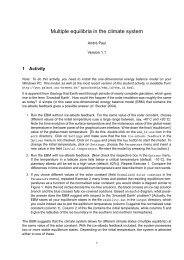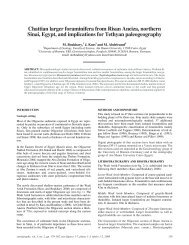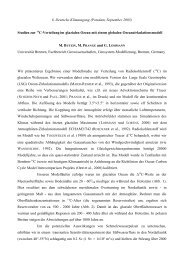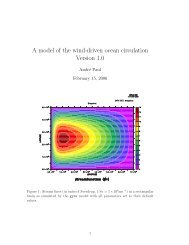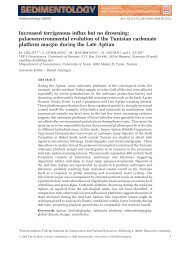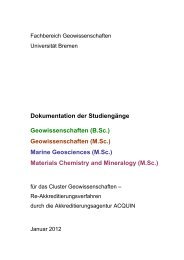Forschung im HLRN-Verbund 2011
Forschung im HLRN-Verbund 2011
Forschung im HLRN-Verbund 2011
- Keine Tags gefunden...
Sie wollen auch ein ePaper? Erhöhen Sie die Reichweite Ihrer Titel.
YUMPU macht aus Druck-PDFs automatisch weboptimierte ePaper, die Google liebt.
180Ab Initio Solution of QCD, the Fundamental Theory of MatterLattice QCD at Physical Quark MassesG. Schierholz, Deutsches Elektronen-SynchrotronDESY and University of HamburgAbstract• The only existing possibility to solve QCD at allscales is by numerical s<strong>im</strong>ulation on a spacet<strong>im</strong>elattice.• The calculations are now reaching a level, wherethey are able to not only complement, but provideguidance to current and forthcoming exper<strong>im</strong>entalprograms at the leading research facilities.• Ab initio calculations of a wealth of hadronic observablesmay be expected in the years to come.Quantum chromodynamics (QCD) is the fundamentaltheory of the strong interactions. Itbinds quarks and gluons, the fundamental buildingblocks of matter, to nucleons and mesons, andthese to nuclei. The forces between quarks andgluons are so strong – equivalent to a weight forceof more then 10 tons – that quarks do not appearas free particles in Nature. This phenomenonis called quark confinement. The equations ofthis theory are so complicated that they cannot besolved by traditional techniques.Lattice QCD provides the only ab initio methodfor solving QCD. This is achieved by numerical s<strong>im</strong>ulations.For the computer to solve the theory oneapprox<strong>im</strong>ates space and t<strong>im</strong>e by a finite box dividedinto a discrete set of points, the lattice. Thisreduces the problem to a finite system of coupledequations, which can be solved by standard MonteCarlo techniques. Later on one removes this approx<strong>im</strong>ationby letting the lattice spacing go to zeroand the box size to infinity.Since the cost of Lattice QCD computationsgrows with a large inverse power of the quarkmass, initial calculations were restricted to relativelyheavy quarks. However, in order to capturethe physics of quarks and gluons in captivity, andreach the needed accuracy requested by the exper<strong>im</strong>ents,s<strong>im</strong>ulations at physical quark masses,on large volumes and at small lattice spacings arerequired. Due to continuous <strong>im</strong>provements of thealgorithm, and the advent of Petaflop/s-scale computingfacilities, we are now able to perform s<strong>im</strong>ulationsat the physical quark masses.From the numerical point of view, the task is tosolve a system of linear equations, b = Q † Qx, iteratively,where Q is a sparse, more than 300 million× 300 million complex matrix on current lattices.In a typical run more than 80% of the total t<strong>im</strong>eis spent in multiplication of vectors with the matrixQ. The calculation requires the exchange of ghostcells of the input vector. In order to scale QCD programsto high numbers of processers, a communicationnetwork with high bandwidth and low latencyis needed. Although the Altix has an excellent network,the loss due to communication is typically ofthe order of 50%.The pr<strong>im</strong>ary goal of this project is to achievea truly quantitative understanding of the spectrum,the structure and the interaction of hadronsin terms of their quark and gluon constituents.This involves the calculation of hadron form factors,distribution amplitudes, moments of structurefunctions, as well as transversity and generalizedparton distributions (GPDs). These observablesare directly relevant to exper<strong>im</strong>ents at CERN/LHC,GSI/FAIR, JLab, MAMI and RHIC-spin. A recentresult [1] on the quark distribution of the proton isshown in Fig. 1. A further goal is to find out whetherthe Standard Model is able to describe the flavorand CP violation observed in nature. To shed lighton this question, a selection of CKM matrix elementswill be determined with high accuracy andwell understood errors from meson and hyperondecays. Arguably, the most compelling indicatorof new physics beyond the Standard Model is theanomalous magnetic moment of the muon, a µ =(g − 2) µ /2. At the very least, it represents a majorconstraint for speculative new theories such as supersymmetryor extra d<strong>im</strong>ensions. The current exper<strong>im</strong>entalvalue of a µ shows one of the largest deviationsof any observable from the correspondingStandard Model prediction. For a quantitative testa calculation of the QCD corrections is needed thatmeets at least the exper<strong>im</strong>ental precision. That iscurrently not the case.It turns out [2], not unexpectedly, that the structureof hadrons changes dramatically with decreasingquark masses. In Fig. 2 I show very recent resultson the magnetic moment of the nucleon as afunction of the pion mass. (It is customary to expressthe mass of the quarks by the correspondingpion mass through the relation m q ∝ m 2 π.) Onlyat the physical pion mass (∗) does the nucleon developits given structure. This is due to the pioncloud, which extends to distances ∝ 1/m π fromthe center of the nucleon, and will only unfold atlight enough masses. The magnetic radius of thenucleon even appears to diverge like 1/m π at vanishingquark masses, in agreement with effectivemodels. This raises the question if a world of mass-Physik




